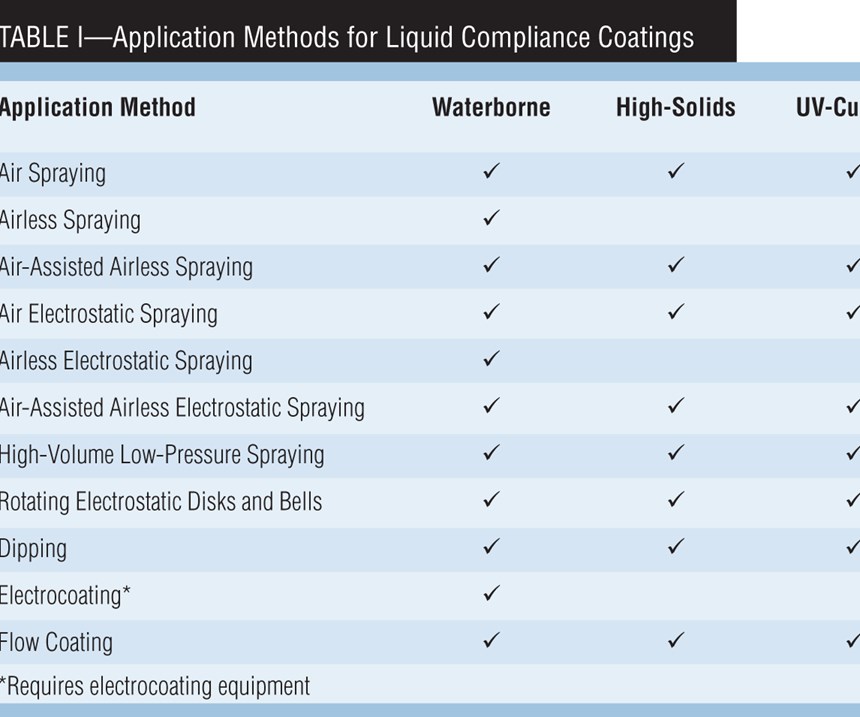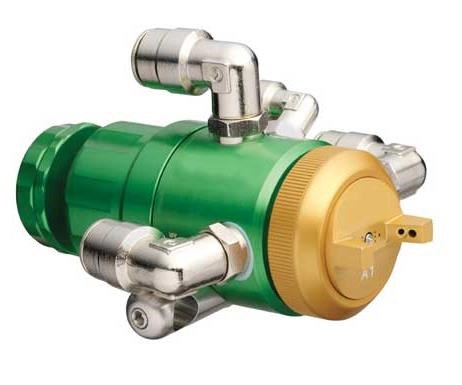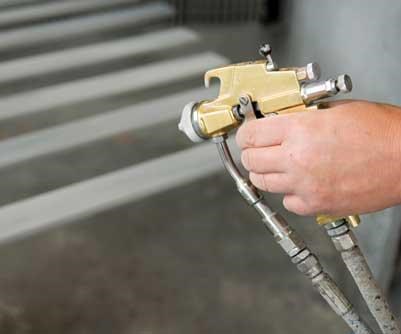Paint Application Methods
An overview of spraying, dipping, flow coating, and everything in between.
Share
Read Next
Compliance with government regulations for reducing air pollution associated with paint application relies on use of coatings containing less-organic solvent (volatile organic compounds or VOCs) as well as application methods that improve transfer efficiencies.
Transfer efficiency is a measure of the percentage of coating material that actually coats the product versus that wasted in the form of overspray. High transfer efficiency not only helps meet environmental regulations and cuts costs, it also provides a safer workplace. Table I shows compliance coatings and their application methods. Three basic methods apply paint in production installations: spraying, dipping and flow coating. Spraying is by far the most frequently used.
Industrial Spray Painting Methods
Spray-painting equipment can be classified by atomization method: air, hydraulic or centrifugal. These general types can be subdivided further: conventional air-atomized, airless, air-assisted airless, air electrostatic, airless electrostatic, air-assisted airless electrostatic, high-volume low-pressure (HVLP), and rotating electrostatic disks and bells.
(Related: How do I choose the right spray technology for my application?)
Air-atomized spraying
Air-atomized spraying relies on paint pumped under pressure to conventional spray guns, so that it mixes with a stream of compressed air either internally or externally. The compressed air breaks up the liquid stream or atomizes it, causing it to break up into droplets that form a spray.
Most internal-mix guns have controls to regulate fluid flow, atomizing air and spray patterns. Since these adjustments allow the guns to meet the finishing requirements of a variety of sizes and shapes, conventional spray guns are used for coating many high-quality items. They can apply catalyzed, high-solids and waterborne coatings, as well as more traditional finishes.
The greatest asset of conventional air-atomized spray equipment is its versatility. In the hands of a skillful operator, a spray gun can coat practically any object. It can apply various coatings whose viscosity, flow and drying rate are controlled by solvent blending and adjustment of the application environment. A problem is that organic solvents used for thinning are costly. And in the application process they evaporate into the atmosphere, have lower transfer efficiency and contribute to formation of photochemical smog.
In addition to their relatively low transfer efficiency, conventional spray guns used with organic-solvent-thinned paints produce overspray and solvent evaporation, requiring large volumes of make-up air and high exhaust rates to protect workers. Despite all these considerations, however, the versatility of conventional spray is difficult to match. Thus, it is still widely used.
Airless Spraying
Airless spraying forces paint under pressure through a small orifice in the gun, atomizing it in the same manner as a nozzle attached to a garden hose atomizes water. Upon emerging from the orifice, the tremendous internal pressure causes the paint stream to blow apart into atomized droplets. The viscosity of the paint, the size of the orifice and hydraulic pressure determine the speed at which the fluid emerges from the gun. Unlike air-atomized spraying where compressed air imparts a greater velocity to coating droplets, causing overspray and blowback, airless spraying lessens overspray and blowback. Only their own momentum (not compressed air) propels the droplets. This accounts in part for the higher transfer efficiency.
Heating the coatings applied by airless spray using in-line heaters has the same effect as adding solvents—it lowers viscosity. Thus, hot airless spraying can apply paint at lower fluid pressure. The coating viscosity, amount of solvent required and overspray are commensurately reduced. Higher-viscosity paints using less solvent can be sprayed. Consequently, finishing with hot airless spray equipment reduces air pollution and decreases the amount of coating residue requiring disposal. It also compensates for seasonal changes in ambient temperatures.
HVLP Spraying
High-volume low-pressure spraying originally relied on turbines supplying high volumes of low-pressure, heated air to HVLP spray guns. The use of heated air lessens the cooling associated with air and airless atomization. This not only reduces the tendency to condense atmospheric moisture but also stabilizes the evaporation of solvent from the coating droplets. Newer, specially designed HVLP spray guns, using compressed air from conventional sources, can replace air-atomizing guns. Because of the low atomizing air pressures, coating droplet velocities are low enough to lessen blowback. Furthermore, lower pressure reduces overspray and eliminates the cloud of vapor associated with conventional spraying.
Air-assisted airless spraying units add compressed air to airless spray. The increased use of high-viscosity, high-solids coatings requires painters to use higher temperatures and higher fluid pressures to atomize paint. In air-assisted airless spraying, compressed air provides additional atomization and pattern control for application of viscous, high-solids coatings, allowing use of lower fluid pressures and paint temperatures.
Electrostatic Spraying
Electrostatic spraying equipment (Read: Benefits of electrostatic sprayers) charges coating droplets as they pass or contact an electrode. It relies upon the attraction of opposite electrical charges. Charged paint particles are attracted electrostatically to the surfaces of the products to be finished, which are usually at ground potential. Not only are the charged coating droplets attracted electrostatically to the front surfaces of these products, they also wrap around and, in some cases, completely coat back surfaces. Because of this “wraparound” effect, electrostatic applicators are especially suitable for coating tubular products.
There are, however, two disadvantages. First is the higher film build on outside corners, edges and around cutouts. This is caused by increased electrostatic attraction in these areas. Second is the lower film build on inside corners and recesses. This is caused by limited electrostatic attraction in these areas, commonly described as the “Faraday cage effect.”
Rotating Electrostatic Disks and Bells
Rotating electrostatic disks and bells take advantage of centrifugal and electrostatic forces to atomize paint. Liquid coating material is pumped into the center orifice of a rotating disk or bell. Centrifugal force propels the coating to the edge of the rapidly spinning disk or bell and into the atmosphere. High voltage concentrated on the machined, razor-edged outer rim charges the coating droplets as they spin off the edge. Paint is attracted to oppositely charged surfaces of parts.
High-viscosity, high-solids coatings (65-percent-volume solids and higher) can be atomized and electrostatically applied using high-rotational-speed disks and bells.
Electrostatic rotating disks are used mostly on automatic lines. A conveyor loaded with parts to be painted loops around the disk in a horseshoe shape.
Rotating electrostatic bells apply coatings in either fixed or reciprocating modes, and also can be used manually or attached to robot arms.
(read: Powder Coating Spray Guns)
Airless Electrostatic Spraying
Airless electrostatic spraying uses high-pressure hydraulic spray guns with a power pack that charges the atomized droplets. The low velocity imparted to these droplets reduces blowback and overspray. Airless electrostatic spray guns are used manually or in automatic modes. They may be installed either as fixed units or in conjunction with reciprocators to coat various products on a conveyor line.
Air-assisted airless electrostatic spraying is really a modification of airless electrostatic spray. The increased use of high-viscosity and high-solids coatings presents problems for airless electrostatic. When heating and higher fluid pressures were used to aid in the atomization of more viscous materials, other problems arose. With the introduction of air-assisted airless spraying equipment, which uses compressed air to provide additional atomization and pattern control, many of these application problems were solved.
Air-atomized electrostatic spraying improves transfer efficiency by use of power packs that electrostatically charge air-atomized droplets. These units may be used manually or automatically, in fixed or reciprocating mountings. Since they impart a higher velocity to coating droplets, their transfer efficiency is lower than that of the other electrostatic units.
Multi-component spraying equipment meters, mixes and sprays multi-component coating materials in one operation. Spraying can be by hydraulic or air-atomizing, internal or external mixing. Aside from having multiple supply and metering pumps feeding a common applicator, these units have the same components as other spray equipment.
Non-Spray Methods of Industrial Paint Application
Dip coating, in its simplest form, involves immersing products to be painted in a tank of coating material, draining off the excess in a solvent-saturated atmosphere and then drying or curing. It is a fast and efficient method that provides coverage in recessed areas. Generally, applications involve those where appearance is not critical. Owing to its simplicity, this method lends itself to conveyors and automation. Viscosity and rate of withdrawal from the tank control film thickness. Dip tanks come in all shapes and are sized to accommodate the largest object to be coated.
Dip coating has its drawbacks: Light parts tend to float and fall from the conveyor; film thickness can vary from top to bottom (“wedge effect”); a fire hazard is created when organic-solvent-thinned paint is used by the large volume of coating in the tank and the solvent-laden atmosphere of the drain tunnel; fatty edges develop on the bottoms of parts as excess coating drains; and refluxing by the solvent vapors above the tank removes some of the coating. Fire hazards and reflux problems encountered with solvent-thinned dip coatings have been eliminated by many finishers who have converted to waterborne paints.
Flow coating overcomes some of the limitations of dip coating. Paint is pumped from a reservoir through hoses and nozzles onto the upper surfaces of the products, where it flows over and down the sides of the products. Excess paint drains into a shallow reservoir to be recycled. The volume of coating required in the system is lower than with dipping; parts will not “float” off the conveyor, and extremely large, complex products too large to dip can be painted. Flow coating can be done with parts on a conveyor that takes them through the enclosure or manually in exhausted booths.
Flow coating, like dip coating, has problems with “wedge effect” and solvent reflux. The process requires careful control of evaporation to obtain uniform coatings. When using waterborne paints, bubbling and foaming control is required. In both the dipping and flow coating methods, hanging of the product is important to its final appearance.
Continuous coaters consist of airless spray nozzles mounted on rotating arms in a special cabinet that reclaims and reuses the coating material. Its operation is similar to that of a flow coater, but it offers better control and applies a more even coating. Continuous coaters can be sized to coat products ranging from pipe to automobile engines.
Centrifugal coating is based on use of a modified dip tank. After small parts are loaded into an inner basket, the tank is filled with sufficient coating material to cover the basket of parts, and then it is emptied. The basket spins rapidly to remove excess coating from the parts by centrifugal force. The surplus coating drains down the inside surfaces of the tank and into a sump to be recycled. Coating viscosity, rotational speed and percent solids control film thickness.
(Related: Is Centrifugal Coating right for my finishing operation?)
This method, sometimes called “dip-spin” coating, is used extensively for finishing fasteners and other small parts in large volumes where appearance is not critical.
Curtain coaters are modified flow coaters, used mainly on high-speed, conveyorized production lines for coating flat substrates. The coating material is pumped to and flows from a slotted pipe or over a weir, from which it falls by gravity in an unbroken “waterfall” or “curtain.” Objects passing under the “curtain” are coated. Low-profile, three-dimensional objects can be coated on all six sides in two passes. Excess coating material collects in a gutter and returns to the reservoir to be reused. Flow rates and conveyor speeds control film thickness.
Roller coating is used extensively for finishing flat sheets and coiled metals. Coatings are rolled onto surfaces by resilient rollers. When the substrate and rollers travel in the same direction and at the same speed, the method is called direct roller coating. On the other hand, when the roller motion is contrary to that of the sheet or strip, the method is called reverse roller coating. When applied on a continuous strip, it is called coil coating. Painted coil material can be fabricated to make prefinished products of various sorts, including roofing, siding, appliance cabinets, signs, containers, etc. Coil coating requires a major investment in capital equipment. Basic metal producers and private concerns called “toll coaters” often perform this process.
Electrocoating is dip coating that uses an applied electrical current to attract paint to oppositely charged surfaces of parts being painted.
(Read: Finding what causes defects in e-coat systems)
Autodeposition is similar to electrocoating, but, in this case, a waterborne paint is deposited as the result of chemical reactions only, with no externally applied electrical current. No pretreatment beyond thorough cleaning is required. A standard rinse and post-rinse with deionized water removes residual coating from the surfaces of parts that have been through the autodeposition tank. This rinse stops the reaction process.
Autodeposition requires a low-temperature curing cycle (220–230°F) after the coating is applied. Used primarily on steel surfaces, autodeposition is capable of coating any surface of a part that can be wetted by the coating material. The thickness of the coating is self-limiting, ensuring uniform film thickness. Equipment is said to occupy 30-percent less floor space than that of an electrocoat system, and capital investment is said to be 25- to 30-percent less than that required for electrocoat. Because autodeposition uses waterborne coatings with no organic solvents, no air pollution controls are required. Racks do not require stripping, since the cured coating prevents further deposition.
Achieving Higher Transfer Efficiency in Liquid Coating
Having answered the question about how coatings are applied, the next question is how can they be applied in the most effective manner? To answer that question, the product’s size, shape, ultimate appearance and intended use must be addressed. The transfer efficiency (TE) of the application equipment also is important. However, since various suppliers who may calculate TE without benefit of a standard measurement method provide these values, the TE for the application methods described here will not be listed.
(Related: The Powder Coatings Institute has a cool app for Coating cost comparisons.)
Using a coating method having higher transfer efficiency can reduce finishing costs. Consider, for example, a product requiring 1 gal of 100-percent solids coating for complete coverage. When using spray equipment whose transfer efficiency is 30 percent, 3.33 gal must be sprayed to apply 1 gal on the product. At a more common volume, solids of 50 percent, 6.66 gal must be sprayed. By switching to a spraying system whose transfer efficiency is 70 percent, only 2.85 gal of 50-percent- solids coating must be sprayed. Going a step farther, if the coating is applied at 75-percent solids, only 1.9 gal must be sprayed. Savings in solvent costs can be calculated by subtracting 25 percent of 1.9 gal from 50 percent of 6.6 gal, which leaves 2.85 gal.
Coating cost savings can be calculated using the same example. In the first case, 3.33 gal of coating solids are sprayed, and, in the third case, 1.43 gal of coating solids. By subtracting 1.43 from 3.33, we show a saving of 1.9 gal of coating solids. Furthermore, as much as 2.33 gal of coating overspray (a waste product) can be avoided.
Since these calculations can be applied to most coating methods, (See Calculating the cost of Power Coating) material costs can be reduced in most finishing operations by using more transfer-efficient application equipment. To achieve these higher efficiencies, coatings are applied today by the newer, more efficient methods as well as by conventional equipment, using automated systems involving robots, program-controlled reciprocators and automatic conveyorized lines.
By careful consideration of the governmental regulations, the product’s size, shape, ultimate appearance, need for corrosion protection and intended use, as well as a review of the coating methods described above, all the questions posed can be answered.
Related Content
Anodizing for Bonding Applications in Aerospace
Anodizing for pre-prep bonding bridges the gap between metallic and composite worlds, as it provides a superior surface in many applications on aluminum components for bonding to these composites.
Read MoreCuring Oven Basics
Simply heating up the substrate does not cure the coating. There are many variables to consider when choosing the best cure oven for your application...
Read MoreHow to Maximize Nickel Plating Performance
The advantages of boric acid-free nickel plating include allowing manufacturers who utilize nickel plating to keep up the ever-changing regulatory policies and support sustainability efforts.
Read MoreAn Overview of Electroless Nickel Plating
By definition, electroless plating is metal deposition by a controlled chemical reaction.
Read MoreRead Next
Delivering Increased Benefits to Greenhouse Films
Baystar's Borstar technology is helping customers deliver better, more reliable production methods to greenhouse agriculture.
Read More





















